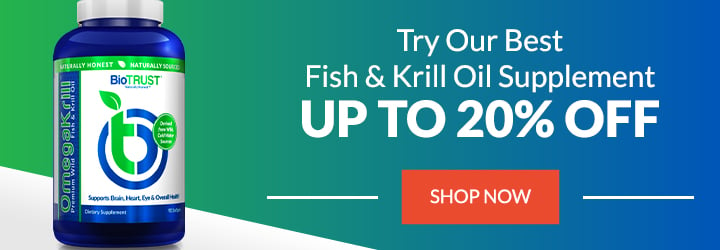18+ Foods That Are Rich in Omega-3 Fatty Acids

Despite past advice, a low-fat diet isn’t the healthiest choice. In fact, some fats, such as omega-3s, are vital to a healthy body. Why do you need to include foods rich in omega-3 in your diet? Because your body can’t produce them on its own.
What are Omega-3s?
With all the nutrients out there, what are omega-3s, and what makes them different (and necessary)? First, omega-3s are what’s called an “essential nutrient,” meaning you need to have it in your diet as your body can’t produce it. In other words, because our bodies don’t naturally manufacture this nutrient, we have to get it from food and/or supplements.
Omega-3s are comprised of, you guessed it, three parts. They are docosahexaenoic acid (DHA), eicosapentaenoic acid (EPA), and alpha-linolenic acid (ALA). Fatty fish, seaweed, and algae are wonderful sources of DHA and EPA, while certain nuts, seeds, and plants provide a good deal of ALAs.
How Much Omega-3 Do You Need?
It’s important to get your healthy fats in and it’s especially important to consume the ultra-healthy and less abundant omega-3s. How much do you need every day? Omega-3 daily requirements vary by age. According to the National Institutes of Health, the recommended adequate intake of omega-3s by age are as follows (by years of age):
- 0 – 1: 500 mg
- 1 – 3: 700 mg
- 4 – 8: 900 mg
Then it splits into different amounts for men and women, again based on age:
- 9 – 13: 1,200 mg for men and 1,000 mg for women
- 14 – 18+: 1,600 mg for men and 1,100 mg for women
What are the Benefits of Omega-3s?
Foods rich in omega-3s have many benefits, and they can compound over time to support optimal health. Some of these benefits include:
1. Support a healthy mood—omega-3 fats are documented to help support a healthy mood and may help decrease depression and reduce anxiety.
2. Protect your eyes—omega-3s are known for promoting eye health and may even lessen the chances of developing macular degeneration.
3. Support healthy inflammation levels—omega-3s help support the body’s response to inflammation.
4. Support brain health—studies have found infants who receive sufficient omega-3 in the womb throughout pregnancy and continuing after birth may be smarter and may have a reduced risk of developing ADHD and autism. They may also have better communication skills.
Long-term intake of healthy levels of omega-3s over one’s lifetime may also help prevent Alzheimer’s disease.
5. Support heart health—this is a biggie when it comes to omega-3s. Studies have found that omega-3 fatty acids may help prevent arterial plaque and blood clots from forming. They may also support healthy levels of good cholesterol (HDL) and triglycerides.
DHAs mainly appear to benefit your eyes and brain, but they may also help promote healthy joints and overall health. The cognitive benefits are remarkable as plenty of DHAs may help boost both learning ability and memory. EPAs are famous for supporting heart health by helping control lipids (blood fats) and lower blood pressure and help the body healthfully respond to inflammation. Lastly, ALAs may help improve mood to potentially ease depression and boost brainpower.
Foods Rich in Omega-3 Fatty Acids
Believe it or not, fatty or oily fish can actually be one of the healthiest additions you can make to your diet plan. So if you don’t like fish, you might want to play with some recipes to find ones you enjoy because they contain so many of the good fats.
Here are some great suggestions with the amounts of omega-3s per 100-gram serving (about 3.5 ounces):
Mackerel—this fish boasts a whopping 5,134 mg/100 grams. It’s often smoked but can also be grilled or roasted (often with lemon and garlic).
Herring—this fish has 2,366 mg/100 grams. You’ll typically see this as pickled or smoked.
Salmon—provides 2,260 mg/100 grams. You will see both wild-caught and farmed varieties. Wild-caught is more expensive but is also healthier for you and provides more omega-3 fatty acids in each serving.
Anchovies—these little fish have 2,113 mg/100 grams. These are usually canned.
Sardines—these little powerhouses pack 1,480 mg/100 grams and can usually be found canned.
Oysters—they have 436 mg/100 grams. Oysters also contain ALA, so they are a complete source of omega-3a.
Other foods rich in omega-3 fatty acids include sea bass, shrimp, and trout. If you’re interested in vegan-friendly sources, both seaweed and algae boast high levels of omega-3s.
Other Delicious Foods High in Omega-3s
Besides the oily fish, there are several other foods rich in omega-3s you can add to your diet to round out the nutritional value, including nuts, seeds, oils, and other plant sources. These include:
- Kidney beans
- Edamame
- Flax seeds—these little seeds just might be the best all-around source for ALAs. Whether you use them whole, ground, or in oil form, they’re a great source!
- Chia seeds
- Soybeans—that includes whole soybeans as well as soybean oil
- Canola oil
- Walnuts
Other foods rich in omega-3 fatty acids (but not as rich as those listed above) include grass-fed meats, some veggies like Brussels sprouts and spinach, and seeds like hemp. Again, aim for various food sources and try to include foods that contain each type of omega (DHA, EPA, and ALA). In addition, you may also choose to use a high-quality supplement to round out your nutrition. Besides omega-3 supplements, you can also try cod liver oil and krill oil for excellent high-omega-3 alternatives.







